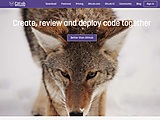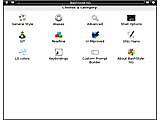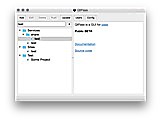 Tig: text-mode interface for Git Tig is an ncurses-based text-mode interface for git. It functions mainly as a Git repository browser, but can also assist in staging changes for commit at chunk level and act as a pager for output from various Git commands.
Tig: text-mode interface for Git Tig is an ncurses-based text-mode interface for git. It functions mainly as a Git repository browser, but can also assist in staging changes for commit at chunk level and act as a pager for output from various Git commands.
 git-annex allows managing files with git, without checking the file contents into git. While that may seem paradoxical, it is useful when dealing with files larger than git can currently easily handle, whether due to limitations in memory, checksumming time, or disk space. Even without file content tracking, being able to manage files with git, move files around and delete files with versioned directory trees, and use branches and distributed clones, are all very handy reasons to use git. And a
git-annex allows managing files with git, without checking the file contents into git. While that may seem paradoxical, it is useful when dealing with files larger than git can currently easily handle, whether due to limitations in memory, checksumming time, or disk space. Even without file content tracking, being able to manage files with git, move files around and delete files with versioned directory trees, and use branches and distributed clones, are all very handy reasons to use git. And a
 Multi-git-status shows uncommited, untracked, unpushed and unpulled changes in multiple Git repositories.
Multi-git-status shows uncommited, untracked, unpushed and unpulled changes in multiple Git repositories.
 GitLab is a development collaboration tool and git DVCS frontend. It includes repository management features, code reviews, an issue tracker, activity feeds and wikis. GitLab provides fine-grained access control, user management, 5 permission levels and branch constraints, and can utilize LDAP/AD intranet authorization. Powered by Ruby on Rails it comes as open source package, and as commercial supported enterprise version.
GitLab is a development collaboration tool and git DVCS frontend. It includes repository management features, code reviews, an issue tracker, activity feeds and wikis. GitLab provides fine-grained access control, user management, 5 permission levels and branch constraints, and can utilize LDAP/AD intranet authorization. Powered by Ruby on Rails it comes as open source package, and as commercial supported enterprise version.
 Forgejo is a self-hosted lightweight software forge. Easy to install and low maintenance, it just does the job. Brought to you by an inclusive community under the umbrella of Codeberg e.V., a democratic non-profit organization, Forgejo can be trusted to be exclusively Free Software. You can create an account on Codeberg and other instances or download it to self-host your own. It focuses on security, scaling, federation and privacy. Learn more about how it compares with other forges.
Forgejo is a self-hosted lightweight software forge. Easy to install and low maintenance, it just does the job. Brought to you by an inclusive community under the umbrella of Codeberg e.V., a democratic non-profit organization, Forgejo can be trusted to be exclusively Free Software. You can create an account on Codeberg and other instances or download it to self-host your own. It focuses on security, scaling, federation and privacy. Learn more about how it compares with other forges.
 Gitea is a painless self-hosted Git service. It is similar to GitHub, Bitbucket, and GitLab. Gitea is a fork of Gogs. See the Gitea Announcement blog post to read about the justification for a fork. Purpose The goal of this project is to provide the easiest, fastest, and most painless way of setting up a self-hosted Git service. With Go, this can be done with an independent binary distribution across all platforms and architectures that Go supports. This support includes Linux, macOS, and Windo
Gitea is a painless self-hosted Git service. It is similar to GitHub, Bitbucket, and GitLab. Gitea is a fork of Gogs. See the Gitea Announcement blog post to read about the justification for a fork. Purpose The goal of this project is to provide the easiest, fastest, and most painless way of setting up a self-hosted Git service. With Go, this can be done with an independent binary distribution across all platforms and architectures that Go supports. This support includes Linux, macOS, and Windo

Git is a distributed version control system, originally designed for Linux kernel development and large projects with non-linear workflows. It's comprised of individual tools, reuses ssh and rsync protocols, emphasises speed and data integrity, and keeps every checkout as full-fledged repository, and cryptographically authenticates source history. Various graphical frontends, IDE integrations and web services (GitHub) exist; with its git-fast-export format meanwhile serves interoperability with
minor feature: A new configuration variable remote...serverOption makes the, transport layer act as if the --serverOption=. option is, given from the command line. "git rebase --rebase-merges" now uses branch names as labels when, able. Describe the policy to introduce breaking changes. Teach 'git notes add' and 'git notes append' a new '-e' flag, instructing them to open the note in GIT_EDITOR before saving. Documentation for "git bundle" saw improvements to more prominently, call out the use of '--all' when creating bundles. Drop support for older libcURL and Perl. End-user experience of "git mergetool" when the command errors out, has been improved. "git bundle --unbundle" and "git clone" running on a bundle file, both learned to trigger fsck over the new objects with configurable, fck check levels. When "git fetch remote" notices that refs/remotes/ remote/HEAD is, missing and discovers what branch the other side points with its, HEAD, refs/remotes/ remote/HEAD is updated to point to it. "git fetch" honors "remote...followRemoteHEAD" settings to, tweak the remote-tracking HEAD in "refs/remotes/. /HEAD". "git range-diff" learned to optionally show and compare merge, commits in the ranges being compared, with the --diff-merges, option. Document "amlog" notes. The way AsciiDoc is used for SYNOPSIS part of the manual pages has, been revamped. The sources, at least for the simple cases, got, vastly more pleasant to work with. The reftable library is now prepared to expect that the memory, allocation function given to it may fail to allocate and to deal, with such an error. An extra worktree attached to a repository points at each other to, allow finding the repository from the worktree (and vice versa), possible. Use relative paths for this linkage. Enable Windows-based CI in GitLab. Commands that can also work outside Git have learned to take the, repository instance "repo" when we know we are in a repository, and, NULL when we are not, in a parameter. The uses o
 GNU LGPL c git scm vcs dvcs GNU LGPL c git scm vcs dvcs
 A simple terminal UI for git commands, written in Go with the gocui library.
A simple terminal UI for git commands, written in Go with the gocui library.
 Git Large File Storage (LFS) replaces large files such as audio samples, videos, datasets, and graphics with text pointers inside Git, while storing the file contents on a remote server like GitHub.com or GitHub Enterprise.
Git Large File Storage (LFS) replaces large files such as audio samples, videos, datasets, and graphics with text pointers inside Git, while storing the file contents on a remote server like GitHub.com or GitHub Enterprise.
 GitQlient, pronounced as git+client (/gɪtˈklaɪənt/) is a multi-platform Git client originally forked from QGit. Nowadays it goes beyond of just a fork and adds a lot of new functionality. The original idea was to provide a GUI-oriented Git client that was easy to integrate with QtCreator (currently shipped as GitQlientPlugin). This idea has grown since the day 1 to not only cover the integration with QtCreator but also to make it an app on it’s own.
GitQlient, pronounced as git+client (/gɪtˈklaɪənt/) is a multi-platform Git client originally forked from QGit. Nowadays it goes beyond of just a fork and adds a lot of new functionality. The original idea was to provide a GUI-oriented Git client that was easy to integrate with QtCreator (currently shipped as GitQlientPlugin). This idea has grown since the day 1 to not only cover the integration with QtCreator but also to make it an app on it’s own.
 BashStyle-NG is a graphical tool and toolchain for changing the behaviour and look'n'feel of Bash, Readline, Vim, Nano and Git. Possibilities include Bash: 12 fancy pre-defined prompt styles, colors are customizable, random text color, random prompt style for each session possible, create your own prompt using UI, colored manpages (without using most), rembering last visited directory (and restore upon new session), customize bash history settings, lscd: customized variant of cd, showing conte
BashStyle-NG is a graphical tool and toolchain for changing the behaviour and look'n'feel of Bash, Readline, Vim, Nano and Git. Possibilities include Bash: 12 fancy pre-defined prompt styles, colors are customizable, random text color, random prompt style for each session possible, create your own prompt using UI, colored manpages (without using most), rembering last visited directory (and restore upon new session), customize bash history settings, lscd: customized variant of cd, showing conte
 Gittyup is a graphical Git client designed to help you understand and manage your source code history. Gittyup is an open source software developed by volunteers.
Gittyup is a graphical Git client designed to help you understand and manage your source code history. Gittyup is an open source software developed by volunteers.
 Breezy is a version control system implemented in Python forked from Bazaar. It supports multiple repository formats including bzr, git, cvs, mtn, darcs and has an emphasis on hackability.
Breezy is a version control system implemented in Python forked from Bazaar. It supports multiple repository formats including bzr, git, cvs, mtn, darcs and has an emphasis on hackability.
 git-assembler can perform automatic merge and rebase operations following a simple declarative script. Like “make”, for branches. It can be used to follow remote branches (such as pull requests) conveniently, test multiple patches together, work on interdependent feature branches more easily, and so on…
git-assembler can perform automatic merge and rebase operations following a simple declarative script. Like “make”, for branches. It can be used to follow remote branches (such as pull requests) conveniently, test multiple patches together, work on interdependent feature branches more easily, and so on…
 Password management should be simple and follow Unix philosophy. With QtPass, each password lives inside of a gpg encrypted file whose filename is the title of the website or resource that requires the password. These encrypted files can be be organised into meaningful folder hierarchies, which can be shared with teams.
Password management should be simple and follow Unix philosophy. With QtPass, each password lives inside of a gpg encrypted file whose filename is the title of the website or resource that requires the password. These encrypted files can be be organised into meaningful folder hierarchies, which can be shared with teams.
 GitZone is a Git DNS zone file management tool for BIND9. Users can update their zones in a git repository then during a push the zone files are checked, updated & reloaded from git receive hooks. If there’s an error in a file being pushed then the push is rejected, thus only correct files are stored on the server. GitZone-shell is similar to git-shell but it restricts the user to the zones repository and provides some additional commands for dynamic DNS updates & SSH key management.
GitZone is a Git DNS zone file management tool for BIND9. Users can update their zones in a git repository then during a push the zone files are checked, updated & reloaded from git receive hooks. If there’s an error in a file being pushed then the push is rejected, thus only correct files are stored on the server. GitZone-shell is similar to git-shell but it restricts the user to the zones repository and provides some additional commands for dynamic DNS updates & SSH key management.
 Caja extension to add important information about the current git directory. This project is based on nautilus-git by Bilal Elmoussaoui.
Caja extension to add important information about the current git directory. This project is based on nautilus-git by Bilal Elmoussaoui.
|